|
Home |
|
Introduction |
|
Examples |
|
Database |
|
Take Our Survey |
|
John Otteman Collection |
|
A Collector's Dream |
SMITH AND WESSON MODEL 2 ARMY REVOLVER
By Ronald H. Curtis
A site devoted to research for an upcoming book. If you have information to contribute, please use our survey form!
which shows an overview of the Model 2 Army.

Attempting a research project, making a study, or merely observing is both a rewarding and a frustrating experience. It is rewarding due to the new findings, the substantiating and documenting of theories, and the clarifying of known data. It also gives us an opportunity to share experiences and make new friends. The frustration is in the difficulty of securing enough data to make positive conclusions.
The observations made here are not the final work on the Model 2 Army. Indeed they are only a beginning, but hopefully they will be a stepping stone to enable the next student to do a better job.
According to published sources, 77,155 Model 2 Army revolvers were made. To date, the serial numbers on observed specimens have not substantiated this figure, 76,642 being the highest number noted. Unfortunately, the Smith & Wesson factory records for this period are incomplete and do not give a comprehensive picture of production.

The first delivery of #2s was made on June 22, 1861, a shipment of three revolvers with 6 inch barrels to J.W. Storrs of New York City. Although these revolvers remained basically the same throughout production, many minor variations were introduced. Eight basic types have been identified:
Type I. Recorded serial range 45 - 312.
This first type has a two pin frame and a second grip retaining pin at the top of the rear strap. Barrel lengths are usually 6" and the lowest 5 " noted is #173. Eight original nickel finishes recorded.
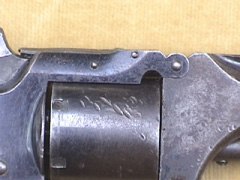 Two Pin Frame |
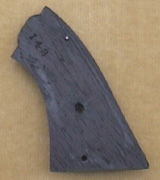 Pin in Grip |
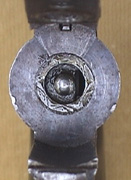 Recoil Shield Short |
Type 2. Recorded serial range 550 - 3647.
Basically the same as the first type, the extra grip retaining pin was dropped. This group is about equally divided between 5 & 6 inch barrel lengths and about a quarter of the recorded specimens are nickel plated.
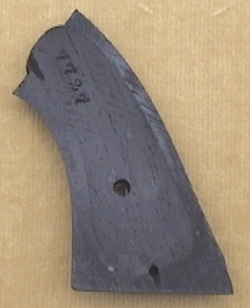
Grips Without Pin
Type 3. Recorded serial range 3109 - 10121
The very noticeable change in this type is the addition of third pin to the top strap to limit the travel of the cylinder stop. Note the overlap in serial numbers between this and Type 2. Such overlaps are common in S&W production. 2600 of this type were bought by S. Kittridge in 1862. These were marked "Manufactured for S. Kittridge & Co., Cincinnati, Ohio" on the left side of the barrel.
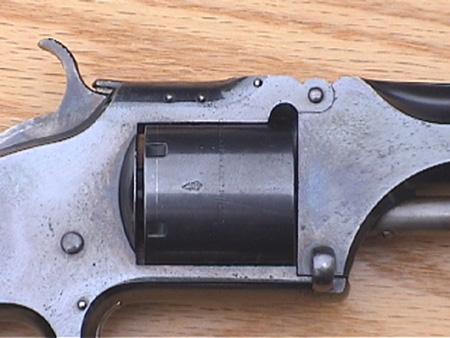
Three Pin Frame
Type 4. Recorded serial range 10627 - 40044
This type is the same as type 3 except for an increase in the size of the serial number stamps. The tiny number dies used since the beginning of production on the 1st Model 1st Issue, were abandoned and number dies about twice as large were substituted. Most of the specimens observed in this group had 6" barrels, although there were some 5 ", two 4" and one 8" (#15702, sold Dec. 9, 1863 to J.W. Storrs, NYC.) The day books for this period also show 10 with 4 "' barrels shipped to N. Curry, San Francisco, on October 29, 1864.
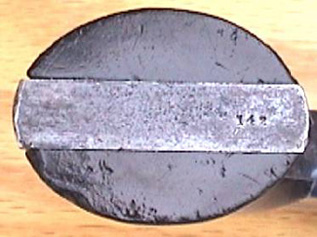 Old Style |
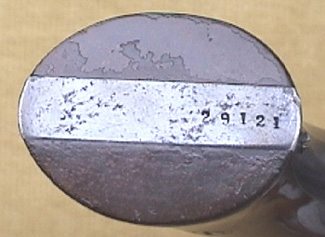 Later Style |
Type 5. Recorded serial range 37188 - 59680
This variation appears to be an attempt at economy as the final milling cut on the breech face was eliminated. It is easy to imagine that this would have caused a problem with the swelled head of a fired cartridge case catching on the lower portion of the recoil surface. The majority of the #2's with oriental markings fall in this group.
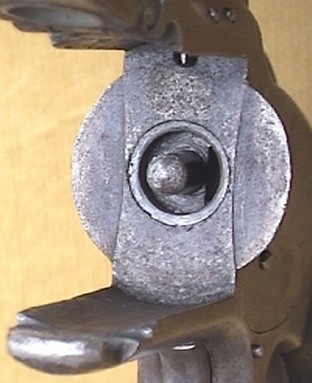 Long Recoil Shield |
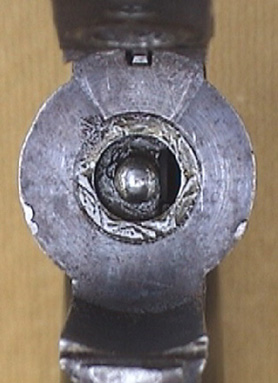 Short Recoil Shield |
Type 6. Recorded serial range 53565 - 60120
Mechanically the same as the last type, the only change in this is the barrel mark. The new die, although the same length as the previous one, has slightly taller letters. An easy way to spot the new die is the absence of the period after "Smith" which was present in the old die, It is interesting to watch the breaking up of the old die. On #3167 only the back or the G in Springfield is broken out. By #41812, the S,M,I, and T in Smith, 0 in Wesson, I,C,I,E,L, and D in Springfield and M,A,S in Mass, are partially broken and some others are thin in places. I am sure the die was changed prior to 50,000 serial range and after 44,602.
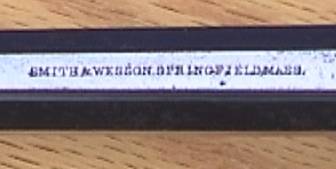
Type 7. Recorded serial range 60120 - 62242
Identical to Type 4 except for the barrel stamping. Either they used some old frames or returned to making the additional cut of the breech face. This is a transition piece where they were just using up parts they had in inventory.
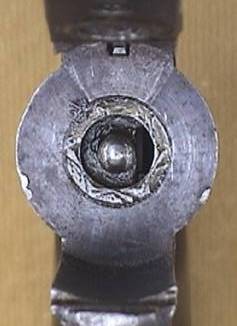
Return to the short recoil shield
Type 8. Recorded serial range 62471 - 71467
Parsons, on page 36 of "Smith & Wesson Revolvers" notes that #2 production ceased during 1867 and was not resumed until existing stocks ran out in 1868. It is probable that the Type 8 guns represent the new production at that time. The differences from the previous type are mostly in the smaller parts. The grip escutcheon is now dished instead of contoured with the grip and grip screw head is rounded instead of contoured (See drawing). The hammer knurling is changed and checkering added to the trigger. The barrel stamp has moved closer to the hinge. Inside of the grip strap of the frame, the mill cut that forms the recess for the lip of the grip is not as deep necessitating a smaller lip on the grip.
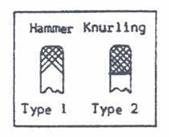
|
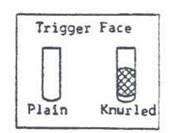
|
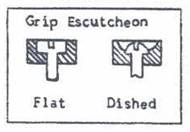
|
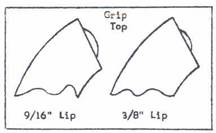
|
Type 9. Recorded serial range 71759 – 76662
Identical to type 8 except hinge screw changed to flat head flush with frame. I am not sure about this one. It appears that the plain Jane number twos have the flat screw, but the special finished and engraved ones have the rounded head. We need more data.
An assembly mark is found on the face of the cylinder, the rear or the barrel, and on the frame under the grip. This assembly number will be the same or, if it is a mismatched gun, the serial numbers will be on the butt and on the inside of the right grip.
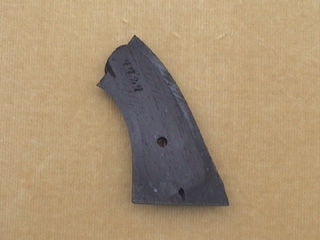 |
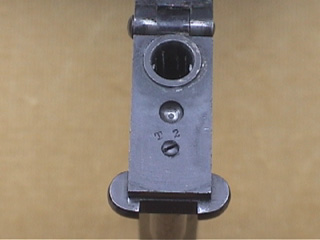 |
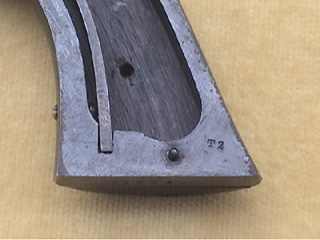 |
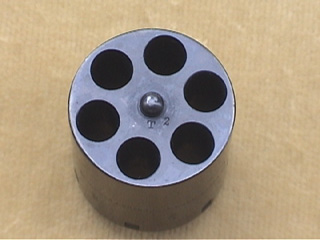 |
This assembly mark may be numbers, letters, or a combination of both. All three assembly marks should match. A large number of special markings are found on the Model No. 2 Army. These include both factory and non-factory markings. Factory markings include "second quality" (on 35 guns), markings put on for purchasers of large quantities of guns (such as the Kittridge Co. marking mentioned above and markings put on for the foreign agents, (Crane and Nunn sales agents in England, Fd. Claudin Prevete A Paris in France, BBNA- British Bank of North America, etc). The factory star was put on guns reworked or refinished at the factory from the late 1800s until 1953. Among the non-factory markings are minor dealer marks and the oriental markings. The oriental markings are usually registration markings. Those translated so far read Japanese: Imperial Arsenal, Police, and Army; and Chinese: Arsenal and Police. Certain special features cannot be attributed to the factory. Those gunsmith additions include shoulder stocks, safeties, re-line and re-chambering jobs, sights and quite often engraving.